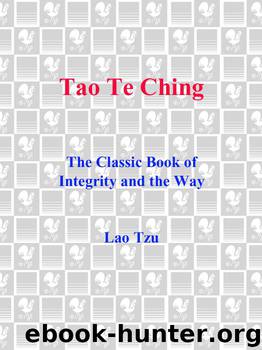Tao Te Ching by Lao-Tzu & Victor H Mair

Author:Lao-Tzu & Victor H Mair [Lao-Tzu & Mair, Victor H]
Language: eng
Format: epub
ISBN: 9780307434630
Published: 0101-01-01T00:00:00+00:00
“This monstrous wound hath outlets nine,
A damp, wet skin doth clothe it o’er;
At every point this unclean thing
Exudeth nasty, stinking smells.”
(Warren, p. 423)
57.6, 7—More literally, “To find it is, as it were, startling, / To lose it is, as it were, startling.” This entire chapter is fraught with awkward scholarly explanations. The original core of the chapter probably consists solely of the first two lines. All of the rest is commentary, much of it quite pedestrian.
57.19—then More literally, “[in] such [a case].…”
58.2,4, 6—“subtle,” “rare,” “serene” The Chinese syllables for the three imperceptible qualities of the One enunciated at the beginning of this chapter all rhyme. Their order in later editions (including the Fu I text) of the Tao Te Ching is “serene,” “rare,” “subtle.” The sounds of these syllables were approximately yuh-hsyuh-wuh in late Old Chinese. The yuh-hsyuh-wuh sequence led to the interesting (and provocative) speculation on the part of several distinguished nineteenth-century sinologists that Yahweh (Jehovah, the Tetragrammaton [YHWH] which seems to mean “the one who exists”) or Īśvara (the self-existent divine power of Hinduism) may have been the ultimate inspiration for the triune Chinese epithet. In fact, yuh-hsyuh-wuh sounds more like Joshua (from a Hebrew expression meaning “the Lord is salvation”) than it does like Yahweh. Be that as it may, the discovery of the Ma-wang-tui texts, which have the sequence wuh-hsyuh-yuh, casts doubt on this particular attempt to link Chinese conceptions of Unity with notions of ineffable godhead elsewhere in Asia. Nonetheless, the question of how to account for the arrangement yuh-hsyuh-wuh in the received tradition remains. Furthermore, this is a typical Chinese method of analyzing polysyllabic foreign words: breaking what was originally a phonetic transcription into its component syllables and then assigning Chinese characters with superficially appropriate meanings to each of them. The same device has long been common in India as well for explicating technical terms. See Chāndogya Upaniad, I.iii.6–7; VIII.iii.5; Advaya-tārakopaniad, 16–17 (Ayyangār, p. 8); and the well-known but wholly false etymologizing of the two syllables of haha (literally “violence” or “force”) as “solar” and “lunar.” Finally, the Tao Te Ching itself says unmistakably just below in line 9 of this chapter that the three qualities are bound together as one unit. For all of these and other reasons which must be omitted because they are even more complex, the three syllables for “subtle,” “rare,” and “serene” should be thought of as constituting a single word whose identity has not yet been firmly established.
59.21—valley The word “broad” has been added to the translation both for cadence and to reflect the implied meaning of the Chinese line.
60.1—I view the final particles of this and the next line as emphatics, not as copulatives. Literally, “arrive empty limit indeed” and “maintain stillness thorough indeed.”
60.14—ducal impartiality The author is playing on the two meanings of kung (“duke” and “public, just, fair, equitable”).
61.11—Literally, “We [are] self-so.” The word for “self-so” in Chinese languages is tzu-jan (modern standard Mandarin pronunciation given). It is often translated as “nature.” See the Afterword, this page, for additional information.
Download
This site does not store any files on its server. We only index and link to content provided by other sites. Please contact the content providers to delete copyright contents if any and email us, we'll remove relevant links or contents immediately.
| Cajun & Creole | California |
| Hawaiian | Mid-Atlantic |
| Midwestern | New England |
| Northwestern | Soul Food |
| Southern | Southwestern |
| Western |
Biscuits: A Savor the South Cookbook by Belinda Ellis(4290)
The French Women Don't Get Fat Cookbook by Mireille Guiliano(3606)
A Jewish Baker's Pastry Secrets: Recipes from a New York Baking Legend for Strudel, Stollen, Danishes, Puff Pastry, and More by George Greenstein(3545)
Better Homes and Gardens New Cookbook by Better Homes & Gardens(3525)
Ottolenghi Simple by Yotam Ottolenghi(3515)
Al Roker's Hassle-Free Holiday Cookbook by Al Roker(3499)
Trullo by Tim Siadatan(3379)
Bake with Anna Olson by Anna Olson(3356)
Hot Thai Kitchen by Pailin Chongchitnant(3320)
Panini by Carlo Middione(3252)
Nigella Bites (Nigella Collection) by Nigella Lawson(3172)
Momofuku by David Chang(3140)
Salt, Fat, Acid, Heat: Mastering the Elements of Good Cooking by Nosrat Samin(3108)
Modern French Pastry: Innovative Techniques, Tools and Design by Cheryl Wakerhauser(3076)
Best of Jane Grigson by Jane Grigson(2946)
Classic by Mary Berry(2942)
Solo Food by Janneke Vreugdenhil(2929)
Tapas Revolution by Omar Allibhoy(2927)
Ottolenghi - The Cookbook by Yotam Ottolenghi(2871)
